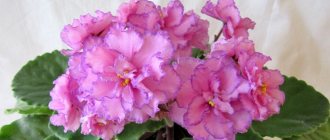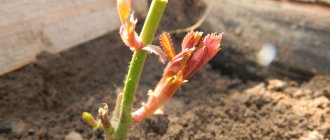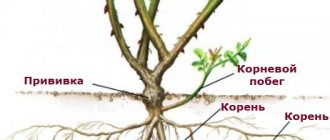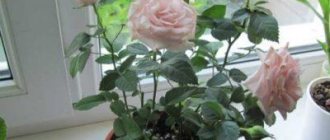Description of the variety Graham Thomas
The yellow rose variety Graham Thomas tolerates diseases well if properly cared for, because in unfavorable years the plant is susceptible to infection, so timely treatment at this time is especially important. The culture is winter-hardy; some flowers do not open in rainy weather. The variety blooms profusely all summer intermittently.
| Color | Yellow |
| Number of flowers per stem | From 3 to 5 |
| Aroma | Strong |
| Flower size | 10-12 cm |
| Bush height | 100-120 cm |
| Bush width | 100 cm |
| Frost resistance | Frost-resistant, zone 6 |
| Powdery mildew resistance | Average, gets sick in unfavorable years |
| Black spot resistance | Average, gets sick in unfavorable years |
| Rain resistance | Average, some flowers do not open when it rains |
| Bloom | Reblooming |
| Bush shape | Spreading |
| Flower | Dense double |
How to propagate?
By layering
The easiest way to reproduce. The procedure is done in August so that the shoot has time to take root.
Rooting scheme for cuttings:
- A strong young shoot is selected.
- The top is cut off, 10 - 20 cm.
- A match is inserted into the middle of the stem where the cut is made.
- The shoot bends down to the soil, attaches itself, and the top is buried at the cut site.
- Abundant hydration.
- After wintering, in the spring, the young seedling is separated from the mother bush.
- Prepare the soil for layering - loosen it, add to the soil:
- humus;
- peat;
- mineral fertilizers.
Cuttings
Strong adult shoots are selected.
Cutting rules:
- The cuttings should have 3 - 4 leaves.
- The lower leaves are torn off.
- The cuttings are planted in special soil.
- The distance between cuttings is 15 cm.
- Each cutting is covered with a transparent container.
- Watering is regular.
- Rooted cuttings are planted in open ground in July in a permanent place.
We would also like to introduce you to other varieties of roses: Agangement, Princess Anne, Lady of Shalott, Grandiflora, Falstaff, Eddie Mitchell, Aqua, Ashram, Golden Celebration, Lady Bombastic.
Appearance and features
Graham Thomas rose has a light yellow tint, not flashy, but rich. The flowers look like drops of liquid honey, some buds have a brighter peach color. The petals on the flowers are tightly packed together to create a perfect cupped shape with a closed core. The edges of the petals are wavy, the buds are densely double and fluffy.
The bush blooms with 3-5 buds of the same color and shape. The plant grows quickly, spreading its shoots with lush green foliage a meter wide. In cool climates, the bush grows up to one and a half meters in height; in the south, the plant can reach two to three meters. The culture is spreading, with many bright roses. The buds are characterized by a pronounced aroma of tea rose.
Photo
anastasy_a_
milas_hobby
ekaterina__illusion_
an_kozyreva
volham
History of origin
The Graham Thomas variety was bred in the UK by the Austin breeding company in 1983. Because of its color, the rose was named Lemon Parody. The variety is considered a hybrid tea, but some experts attribute it to the Shrubs group.
Roses of this shape were popular at the beginning of the 20th century, later roses of the classical form received universal love, but in the 80s of the last century, densely double cupped buds again became in demand.
At the behest of fashion, the Graham Thomas rose appeared. The culture was obtained through crossing the Iceberg and Charles Austin varieties. Rose Graham Thomas is a symbol of love in her homeland, because here they always give yellow roses to lovers when confessing their feelings.
Growing and caring for roses Graham Thomas
To plant Graham Thomas roses, choose sunny areas or places in partial shade. Without sunlight, the buds of the crop will be pale. The plant must be in the sun for at least 6 hours a day. The rose garden with the variety should be located in a place that is well ventilated.
The choice of planting location depends on what kind of shrub the gardener wants to have. If his dreams are for a compact bush with a lot of bright flowers, the area should be in open sun. If you need a spreading, wide bush with dark foliage and small inflorescences, the best choice is partial shade. It is better to plant a seedling in mid-spring or towards the end of autumn.
Reproduction
Roses can be propagated by cuttings and layering. Gardeners do not use seed propagation due to the long process.
The procedure is usually performed after the first wave of flowering. By this time, the shoots become strong and well developed.
For cuttings, select the middle part of the trunk. The top and bottom fragments of the shoot are removed. The lower leaves on the cuttings are cut off completely, the upper ones are shortened by half. Then it is sprinkled with root and planted in the ground.
The lower leaves on the cuttings are removed
Diseases
Does the rose have a gray-white coating or brown balls on the leaves? Methods to combat the disease.
Powdery mildew
Black spots of a round shape have appeared on the leaves of the rose, what should I do, how can I save the plant?
Black spot
The rose is sprinkled with yellow powder, the leaves and stems crack and die, how to get rid of the disease?
Rust
Has a gray coating appeared on the rose? This is gray rot that needs to be gotten rid of as soon as possible.
Gray rot
The seedling must be kept in a solution that stimulates growth for 24 hours. The bush is planted in a hole 50 cm deep, the width of the hole and the distance between the bushes should be the same.
Before planting the plant, the holes need to be watered abundantly, using 10 liters of water for each hole. The roots are carefully distributed over the hole, and the bush is covered with substrate. The grafting bud should be at a depth of 7 cm. The soil should be compacted, and after a day the bush should be loosened and watered.
Rose Graham Thomas loves humidity. Watering should not be excessive so that the roots of the plant do not rot, but the soil should not be allowed to dry out completely. If the top layer of soil has dried out, you must immediately water the plant.
To ensure successful flowering, it is recommended to fertilize the seedlings with fertilizers containing phosphorus and calcium. The optimal period for fertilization is May and June, at which time the buds ripen.
In the autumn, you need to fertilize with potassium. Pruning of spreading shrubs is carried out based on the preferences of the owner of the rose, regarding ideas about landscape design on his site. Sick and frost-damaged shoots must be removed.
Graham Thomas is susceptible to infection with various types of diseases, so you need to carefully monitor the condition of the bush. There must be a drainage layer at the bottom of the hole so that there is no stagnation of moisture in the root system.
After rain, you need to remove drops of moisture from the leaves and buds to avoid sunburn. Most often, the crop of this variety suffers from gray rot, which is formed from stagnant moisture and prolonged rains.
This fungal infection affects the roots. A symptom of the disease is rotting leaves and shoots. If an infection has affected the bush, it is necessary to remove the diseased areas of the plant and carry out disinfection; the substances Alirin-B and Fitosporin-M are suitable.
English roses by David Austin | About the rose
Caring for indoor roses in autumn and winter
Ant Ale
The value of David Austin's English roses is obvious to gardeners. The English breeder, having crossed ancient rose varieties with modern hybrid tea varieties, achieved a magnificent appearance, a rich aromatic spectrum, and a long flowering period of the plant.
Graham Thomas
Ancient rose (French, Bourbon, Damask) imparted aristocratic beauty and a wonderful aroma to the flowers. Modern plants have added practical qualities: varied colors, resistance to external factors, secondary flowering.
Distinctive features of Austin English roses
Rose Abraham Darby
The first ostina was obtained by crossing the modern floribunda rose and the ancient Gallic rose. Today, there are officially more than two hundred species of David Austin roses.
buds
Austins are characterized by both delicate, soft shades and rich, deep colors. Dense, densely double English roses are cup-shaped, pompom-shaped and rosette-shaped. The folded petals in a flower surprise with their multitude and create a velvety effect.
Bushes
The current garden classification classifies most varieties of Austin's Englishworts as scrub roses - shrub roses. The bushes of the plant, unlike the upright hybrid teas and floribundas, have a rounded shape and are well formed. The flowers are located throughout the lush bush, thereby increasing the decorative effect.
Rose A Shropshire Lad
Aroma
English roses are distinguished by their exquisite combination of aromas - from fruity, myrrh, musky shades to the scent of old and tea roses. In the morning and evening their fragrance is especially pronounced.
Flowering duration
The David Austin rose blooms in early June, earlier than other species. Flowers luxuriantly cover the entire bush, starting from its lower part. The end of August, the beginning of September is the time of secondary flowering of the saplings.
Endurance
Rose Benjamin Britten
Many plant varieties have good shade tolerance. They are planted in both partial shade and sun. Winter hardiness is a distinctive quality of the English rose. It tolerates frosts and thaws, heavy snow and its absence well. This Englishwoman is especially good in our climate.
Flaws:
- The disadvantages of peony roses include the rose's sensitivity to rain and humidity. In rainy weather, wet flowers may rot and not bloom. Excessive soil moisture provokes fungal diseases of the plant.
- In extreme heat, English rose flowers become small and quickly fade.
- Flexible branches of bushes often need additional support, but it is easier to winterize the rose.
The advantage of English roses grafted onto a rootstock with white roots is the absence of wild growth.
How to plant an English rose, care features
Rose Ret Austin (Pat Austin)
Before planting plants, compost or rotted manure, preferably horse manure, is added to the soil. Rose roots are pre-treated with growth stimulants. The width and depth of the hole for the rose should be large enough. The remains are usually buried ten centimeters. To form a lush thicket, roses are placed half a meter from each other in a triangle.
June is the time to add nitrogen fertilizers to the soil to better form green mass. During budding, plants need phosphorus and calcium.
When caring for a rose, you should not allow the soil to dry out. In rainy weather there is a risk of the plant becoming infected with gray mold. The color of the bud is light brown; its falling off when touched indicates illness.
The bush needs urgent pruning of the affected part.
For the appearance of new flowers and repeated flowering, the rose is pruned. This procedure is carried out in April before the buds open.
When pruning, low-quality shoots are removed, healing and rejuvenating the plant, and setting the shape of the bush. To grow climbing roses, pruning of lateral and weak shoots is done.
If the rose will serve as a border decoration, all bushes of the plant are cut at the same distance - about sixty centimeters.
Rose James Galway James Galway
In our country, English roses of the varieties Graham Thomas (a favorite of rich yellow color, tea rose aroma), Abraham Darby (apricot shades of the bud, strong fruity aroma), Shropshire Lad (gentle peach color, has a fruity aroma) are popular.
Contrasting orange shades give the rich red buds of Benjamin Britten an unusually elegant look.
English roses by David Austin are a wonderful element of landscape design, an outright joy for connoisseurs of graceful beauty.
Moloshonkova Natalya
Pests
Microscopic spiders have appeared on the plant, and the rose is gradually becoming covered with cobwebs, what should I do?
Spider mite
Are small green insects destroying your rose? Effective methods of pest control.
Green rose aphid
Caterpillars have appeared on the rose and are twisting the leaves of the plant, how to deal with the pest
Rose leaf roller
Flat bumps have appeared on the shoots of the rose or on the underside of the foliage, how to deal with the pest
Rosen scale insect
Several shrubs planted nearby can form a hedge. In the southern regions, where the climate is warm, the rose will begin to grow rapidly upward, so it can be placed along an arch or pergola.
In a flower garden, it is advisable to place a tall bush at the back; annual contrasting flowering plants, for example, petunia, verbena, forget-me-not, etc., will look good next to it. The variety is combined with plants of blue, violet, lilac and blue shades.
Shelter for the winter
Graham Thomas roses are considered very winter-hardy. Short pruning is carried out before winter. The bush is pruned in such a way that only its base with several buds remains. Pruning should be done using sharp, disinfected pruners. After completing the procedure, you need to dig the bush with soil. It is better to take the soil for hilling in another corner of the garden, and not directly next to the rose, since digging it up can injure the roots of the plant. The top of the hilled bush is covered with a layer of foliage, sawdust or spruce branches. If your region has very harsh winters and temperatures drop below -30°C, cover the bush with film to ensure maximum protection. The distance between the film and the plant should be at least 15 cm.
A layer of foliage is poured onto the shelter and covered with branches. In such a house the English rose is kept warm. In spring, the cover is removed in stages: first, branches and leaves are removed, and the bush is left under the film for several weeks. The material allows the sun's rays to pass through and protects the rose from the spring cold - in such greenhouse conditions the bush wakes up and develops faster.
The English rose is an amazingly delicate and charmingly beautiful creation that will certainly attract attention and decorate absolutely any garden plot. Aristocratic sophistication and delicious aroma can conquer the heart and imagination of both the spoiled and the novice gardener.
Useful tips
- When planting spreading shrubs, it is necessary to follow the rules for plant placement. There should be no fruit trees near the rose bushes at a distance of one meter. Otherwise, the crops will take nutrients from the soil from each other, which will negatively affect the growth of both plants;
- The variety is winter-hardy, but it needs to be covered for the winter in severe frost. The bush needs to be trimmed, leaving the base and a few shoots, then sprinkled with soil and covered with sawdust or dry leaves;
- It is recommended to fertilize the Graham Thomas variety according to the principle “It is better to underfeed a little than to overfeed.”
Cultivation Recommendations
The shrub is hardy to weather conditions, resistant to diseases and pests. When growing it, it is enough to adhere to the basic rules of agricultural technology, which include regular watering, pruning, fertilizing and, if necessary, shelter for the winter.
It is recommended to purchase seedlings from nearby nurseries - such plants, as a rule, correspond to varietal characteristics and are better adapted to the local climate
For planting, it is better to choose places that are well lit by the sun; in the shade, the shoots become very elongated and become weak. The plant is suitable for all types of soil, but one should not forget about fertilizing with organic and mineral fertilizers.
The bush is characterized by active growth, so it needs regular pruning. In the northern regions, the height of the plant usually does not exceed 150 cm, and the rose looks like a tall shrub. In the southern regions, the length of the shoots reaches 300 cm; they can be sent along vertical or horizontal supports, and then the plant will have a climbing shape. In a temperate climate, the variety can be grown in two ways - allowing the shoots to grow as much as possible and fixing them on a support, or cutting them in half after the end of the first wave of flowering, which promotes branching and the formation of a lush scrub.
The variety is suitable for cultivation in standard culture
Although “Graham Thomas” is frost-resistant, in the harsh Russian climate it needs winter shelter.
In landscape design, the variety is used for single and group plantings. The rose harmonizes perfectly with plants blooming blue, blue and lilac flowers - irises, clematis, bells, lavender and others.
The bushes look impressive in mixborders and natural flower beds in combination with white and blue-violet flowers
Pros and cons of the variety
Advantages:
- Good immunity, which is ensured by proper care and protects the plant from diseases;
- Bright color and lush buds;
- Sprawling bush with rich greenery;
- Pleasant, intense aroma;
- Frost resistance;
- Different ways to create original landscape design using this culture.
Flaws:
- If not properly cared for, it becomes infected with fungus and other diseases;
- Cannot be grown for cutting due to the location of the inflorescences on the stem;











